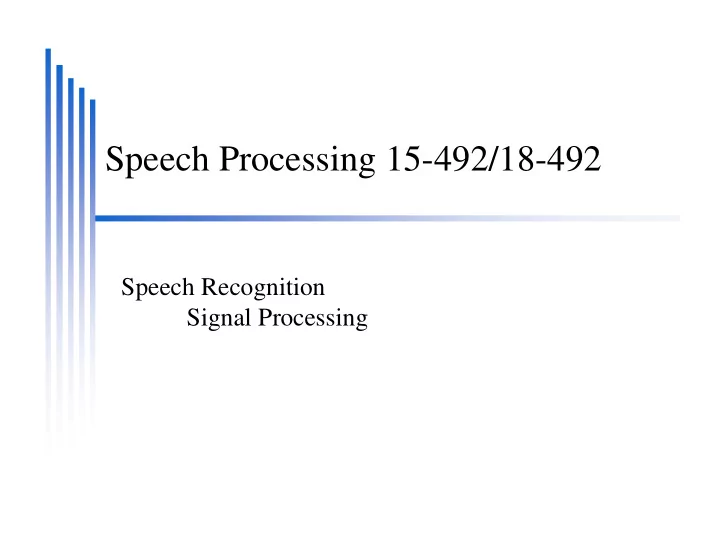

Speech Processing 15-492/18-492 Speech Recognition Signal Processing
Analog to Digital Speech (sound) is analog � Speech (sound) is analog � � Computers are digital Computers are digital � We need to convert We need to convert Sample from A- -D converter D converter � Sample from A � � N times a second N times a second � How many times a second? � How many times a second? �
Goals of Signal Processing Distinguish between phonetic types � Distinguish between phonetic types � Be invariant to channel/room conditions � Be invariant to channel/room conditions � Be invariant to speaker characteristics � Be invariant to speaker characteristics � Computational efficiency � Computational efficiency �
Time vs Frequency Domain Human ear distinguishes frequencies � Human ear distinguishes frequencies � Initial ASR used time domain features � Initial ASR used time domain features � � Power Power � � Zero crossings (sort of frequency) Zero crossings (sort of frequency) �
Source Filter Model Pitch Voiced Pulse Filter Noise Vocal Track Unvoiced Model
Time domain Signal
Waveform Representation
Speech Spectragram
/iy/ vs /ae/ • “beat” /b iy t/ and “bat” /b ae t/
Frequency Domain • “pencils” /p eh n s ih l z/
Frequency Domain • “beats pits” / b iy t s p ih t s /
Speech Analysis
Standard Parameterization Split waveform into “frames” � Split waveform into “frames” � � Advance every 10ms Advance every 10ms � � Size around 25ms (overlapping frames) Size around 25ms (overlapping frames) � � Window them Window them � � Perform FFT/Mel Perform FFT/Mel Cepstral Cepstral analysis analysis � � Find Deltas (difference from previous) Find Deltas (difference from previous) � � Find Delta Deltas (difference in delta) Find Delta Deltas (difference in delta) �
Summary Time domain vs vs Frequency domain Frequency domain � Time domain � Parameterization of speech � Parameterization of speech � � Frequency domain Frequency domain � � Short term Short term FFTs FFTs � � FFT FFT vs vs MEL MEL Cepstrum Cepstrum �
Recommend
More recommend